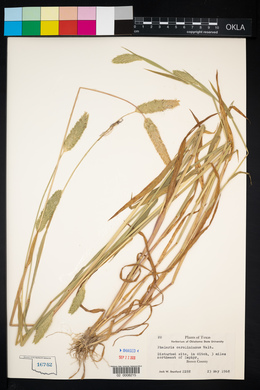Phalaris caroliniana
|
|
|
|
Family: Poaceae
Carolina canarygrass, more...May Grass
[Phalaris americana Elliott, morePhalaris intermedia Bosc ex Poir., Phalaris intermedia var. microstachya (DC.) Vasey, Phalaris microstachya DC., Phalaris occidentalis Nutt.] |
Plants annual; not rhizomatous. Culms to 150 cm. Ligules 1.5-7 mm, truncate to broadly acute; blades 1.5-15 cm long, 2-11 mm wide, smooth, shiny green, apices acuminate. Panicles 0.5-8(8.5) cm long, 0.8-2 cm wide, ovoid to subcylindrical; branches not evident, the spikelets borne singly, not clustered. Spikelets homogamous, all spikelets with a bisexual floret; florets 3; disarticulation above the glumes, below the sterile florets. Glumes 3.8-6(8) mm long, 0.8-1.5 mm wide, keels smooth or scabridulous, narrowly to broadly winged distally, wings 0.1-0.5 mm wide, entire, smooth, lateral veins prominent, usually smooth, sometimes scabridulous, apices acute or acuminate; sterile florets 2, 1.5-2.5 mm, 1/2 or more the length of the bisexual florets, pubescent; bisexual florets 2.9-4.7 mm long, 0.9-1.8 mm wide, pubescent, shiny, stramineous when immature, brown when mature, apices acuminate to beaked; anthers 1.5-2 mm. 2n = 14. Phalaris caroliniana grows in wet, marshy, and swampy ground. It is a common species in suitable habitats through much of the southern portion of the Flora region and in northern Mexico. It has also been found in Puerto Rico, where it may be an introduction, and in Europe and Australia, where it is undoubtedly an introduction. FNA 2007, Cronquist et al. 1977, Kearney and Peebles 1969 Common Name: Carolina canarygrass Duration: Annual Nativity: Native Lifeform: Graminoid General: Robust annual grass with stems to 150 cm. Vegetative: Blades 1.5-15 cm long, 2-11 mm wide, smooth, shiny green, acuminate apices; ligules truncate to broadly acute, 1.5-7 mm, usually deeply lacerate. Inflorescence: Ovoid to subcylindrical panicles 0.5-8 cm long by 0.5-2 cm wide, branches not evident, spikelets borne singly and not clustered; spikelets obovate, imbricate, usually 3 florets per spikelet, the first two sterile and the third bisexual; disarticulation above the glumes and below the sterile florets; glumes subequal, 3.5-6 mm long, 0.5-1.5 mm wide, narrowly to broadly winged distally; bisexual florets 3-5 mm long, 1-2 mm wide, pubescent and shiny, brown when mature. Ecology: Found on wet streambanks and in moist disturbed areas from 1,000-6,000 ft (305-1829 m); flowers July-August. Distribution: Across much of the southern half of the US south to c MEX; also in S. Amer., Europe, and Australia. Notes: Distinguished by being a robust annual grass with dense, condensed, ovoid panicles, the spikelets appearing green and white striped when fresh due to the green wings and veins on the stramineous (straw colored) glumes. Ethnobotany: Seeds were parched and eaten. Etymology: Phalaris is from Greek phalaros, having a patch of white, crested, or phalos, shining, bright, white, while caroliniana means of or from Carolina. Synonyms: None Editor: SBuckley 2010, FSCoburn 2015, AHazelton 2015 Erect annual 3-9 dm; main cauline lvs mostly 5-12 cm נ4-8 mm; ligules 1-3 mm; infl 2-6 cm, cylindric to ellipsoid, spike-like and scarcely or not at all lobed; glumes 4.5-6 mm, glabrous on both sides, scabrous on the narrowly winged keel; sterile lemmas subulate, 1.5- 2.5 mm, pilose, fertile lemma 3-4.5 mm, appressed-pilose throughout; 2n=14. Waste places, roadsides, and wet fields; widespread in Mex. and s. U.S., n. in our range to Va., Md., Ky., and Mo. Gleason, Henry A. & Cronquist, Arthur J. 1991. Manual of vascular plants of northeastern United States and adjacent Canada. lxxv + 910 pp. ©The New York Botanical Garden. All rights reserved. Used by permission. |

























































































